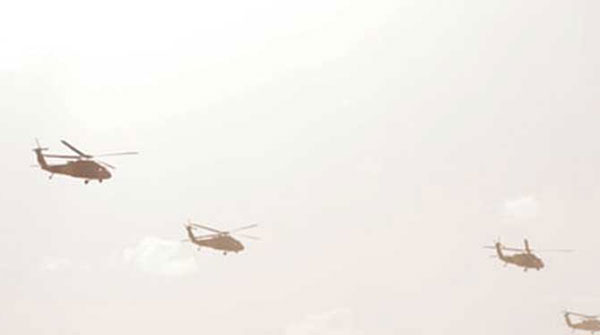 I don’t often write about house-to-house combat, so I’ll seize this opportunity as Russians attempt to seize cities in Ukraine.
I don’t often write about house-to-house combat, so I’ll seize this opportunity as Russians attempt to seize cities in Ukraine.
A primary consideration in war is how to get from one spot to another while supplying your troops. In the U S. Civil War there was a good road from the south winding up to the northern outskirts of Washington. This made it easy for Confederate troops to attack from the north but not easy for Union troops to reverse the process.
Famously, U.S. President Abraham Lincoln watched a battle from this spot, as he occasionally did from balconies in the White House. The President came under fire from Confederate sharpshooters on the second day of the Battle of Fort Stevens (July 12, 1864) – the only time a sitting President has come under direct enemy fire.
The most notable person to encourage the President to get down from a parapet was a young officer named Oliver Wendell Holmes, Jr. He said, “Get down, you damn fool!” Holmes served as Associate Justice of the U S. Supreme Court from 1902 to 1932.
So, terrain is important. If attacking, you want topography like Ukraine – few hills, little marshland, and lots of good roads. If defending, you want the Laurentians or Rockies minus the good roads.
An attacking force should be about three times the size of the defending force. Invaders are on foreign ground and defenders know the geography. Invaders are a long way from home and defenders are defending their homes and families. The zeal, often suicidal, among defenders is a force multiplier. Remember, the weaker side won in the American Revolution and Vietnam.
Airborne missions rarely succeed, as we saw in the Bridge Too Far movie about Operation Market Garden in Holland during the Second World War. It’s hard to supply airborne troops. They jump out of planes unable to stand without aid because of the weight they’re carrying. Their mates push them out and they wiggle free of all their gear once they land. Then they only have what they can carry or use on the spot. Canadian Peacekeepers reminded me that their airborne mission in 1974 to take the Nicosia airport in Cyprus succeeded. There are a few other stellar exceptions.
The next consideration is urban warfare. During the Paris Commune of 1870, it was determined that houses, especially row houses, are really hard for attacking troops to take. Defenders can snipe from windows, the roof, basements, and such. They can also make new little windows that the attackers can’t see well. Inside, defenders can cut holes in walls for manoeuvrability and use ladders in holes they punch in floors to get to unpredictable locations easily. With row housing, defenders can use rooftops and holes in interior walls to be equally unpredictable. While retreating, defenders can leave booby traps or a few troops on a suicide mission.
In modern urban warfare, the easiest thing for attackers to do is to use planes and artillery to destroy entire buildings, as you’ve seen in the news recently and old footage from the Second World War. This is why so many civilians die. However, if you are willing to fight to the death for your home, as in Stalingrad, you can extract a heavy price from the invaders. Even rubble provides cover. Fighting in Stalingrad was so fierce and close that it’s said that tanks were still coming off the assembly line while hand-to-hand combat was proceeding violently at the other end of the factory. Fighting was so close in Nicosia, Cyprus that, after the peacekeepers took over, I could just about touch a Greek machine gun port in the wall of a building while touching the Turkish gun port in the next.
So, as gruesome as it sounds, if Ukrainians are determined to defend their land, they need to get into the cities and get non-combatants and loved ones out, which appears to be exactly what they’re doing. There’s no point in hiding in open ground in which the attackers have armoured vehicles in hot pursuit. There’s little point in trying to supply defenders in open country – airdrops will be seen and picked up by the attackers. Trucks will be shot up and the contents stolen or destroyed.
Pretty much the only strategy is to get military supplies and food into cities by all means possible. Still, planes will be shot down. Even air dropping heavy supplies is dangerous because the sudden shift in weight in the plane can cause instability. If you don’t get shot down and don’t crash, there’s still a chance that the wrong side gets the supplies you’re dropping.
Meanwhile, the invaders must not only transport troops but also guns, vehicles, spare parts, and food. Despite the shortage we see on store shelves, the defenders at least have food closer at hand.
Once into urban warfare, it’s hard to dissuade invaders with economic sanctions and political rhetoric. The more blood lost, the higher the perceived cost of withdrawing. This is sometimes called “sunk costs” or “path dependency” in civilian life. As for sanctions, Putin has a war chest and has no doubt factored in the value of assets he’ll seize in Ukraine, including to feed his troops. That’s what the Union Army did under Grant and Sherman in the American Civil War. It is said they could seize a pig from a plantation, slaughter, cook, and eat it without breaking stride.
War also requires special supplies – oil, fuel, gunpowder, cordite, metals, and rare earth. Hitler made calculations about the necessary supplies he could steal from captured territory, and Putin must have as well.
As for political rhetoric, it’s too late to welcome the former Soviet Union into the family of nations or have NATO move west a bit. It’s also too late to take the eight-year warning Putin issued by annexing Crimea to beef up NATO troops or the six-month warning Putin has given about Ukraine.
It’s also too late for NATO countries to be more equivocal than stating they will not deploy combat troops. Thus, what does Putin have to lose militarily?
It’s also too late for NATO countries to become more reliant on conventional arms rather than nuclear weapons. In the last Cold War, the Soviet Union had overwhelming superiority in conventional weapons and troops – likely also fulfilling some domestic employment goals. We never had enough troops and conventional weapons to repel the Soviet Union, so we kept our nuclear weapons prominent as a deterrent. In short, our primary strategy was the unthinkable.
It’s too late to provide a vigorous response to what is really a multiyear war on the Internet – likely with several bad actors with different motives – Russians, North Koreans, the Chinese, Iranians and mischief-makers. It’s been more than 22 years since Germany muscled AOL into keeping certain types of content out of their country. Germany didn’t have the technology or power to do this, but in the eye-to-eye encounter, AOL blinked. What have we done in other western countries about the Internet, other than blink ourselves?
It’s coming up to two decades since Facebook and Twitter were founded and at least a decade since they’ve been used to foment distrust and dissent in the west. If I were a bad actor and wanted to destabilize NATO and the west, I’d look at the disinformation and misinformation on social media, violence in the streets, and distrust of government, medicine, and such and rub my hands with glee. “Well done!” I’d say.
How to sum up? There’s the tautological refuge – “it is what it is” – is thin gruel. The remaining and real questions include “Is this a new Cold War?” Yes, with Putin more isolated than the old Soviet Union. In fact, Putin has achieved what the European Union, NATO and all other bodies have failed to do. He’s unified the liberal democratic west better than any leader since U S. President Franklin Delano Roosevelt and British Prime Minister Winston Churchill. “Is this the beginning of the Third World War?” It could be, but it looks as if only one side will show up.
Allan Bonner was the first North American to be awarded an MSc in Risk, Crisis, and Disaster Management. He trained in England and has worked in the field on five continents for 35 years. His latest book is Emergency! – a monograph with 13 other authors on the many crises that occurred during the pandemic.
Allan is a Troy Media Thought Leader. For interview requests, click here.
The opinions expressed by our columnists and contributors are theirs alone and do not inherently or expressly reflect the views of our publication.
© Troy Media
Troy Media is an editorial content provider to media outlets and its own hosted community news outlets across Canada.

